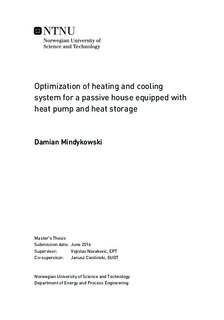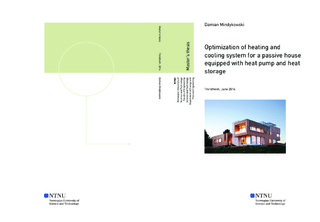| dc.description.abstract | During considerations included in this master thesis re - design of previously developed low energy building destined to be located in Oslo was performed using IDA ICE simulation software. After some construction modifications, retrofit of this building to the passive standard was carried out. Analysis of the previously designed heating system (consisting of transcritical air - based heat pump, thermally - stratified hot water storage tank and top - up electric heaters) for low energy building was conducted, followed by re - design and modification of the heat pump using Dymola with TIL extension and storage tank utilizing IDA ICE. In addition, cooling system was designed and implemented into the passive house in IDA ICE, because there was no cooling system in previous considerations of analyzed building. Subsequently, optimization of both heating and cooling system was performed using mentioned simulation tools. Afterwards, some broader recommendations for design of modern energy supply systems based on use of heat pump and hot water storage tank for residential buildings were listed. Finally, draft proposal for scientific paper based on the main results of the work performed in this master thesis was created and placed in the appendix 1.
Retrofit of analyzed building from its low energy state in previous considerations to the passive standard performed in IDA ICE resulted in 31% drop of its total energy demand (from 40979 kWh down to 28177 kWh annually). The main difference was embodied in energy required for covering space heat demand of the building, therefore it is clearly visible that properly designed passive house is much better insulated building than low energy, although both buildings achieve good performance. In turn, ground source heat pump designed in Dymola achieved SPF of 2,40 in basic configuration (without optimization, including water pump energy consumption), therefore its utility in the passive house resulted in 40% decrease of total electricity supplied to the building, compared to usage of 100% efficient electric heating system (from 28177 kWh to 16955 kWh annually). Furthermore, thanks to performed optimization of both transcritical heat pump, hot water storage tank and cooling system further drop of total electricity supplied to the building was possible - a drop of 30% (from 16955 kWh down to 11931 kWh) was achieved. In case of the heat pump optimization, it resulted in increase of its SPF from 2,40 up to 3,27. For comparison, SPF of previously designed air - based heat pump co-operated with top - up electric heaters was equal to 2,51, what constitutes a value similar to 2,40, knowing that electricity consumption of fans supplying the air flow to the evaporator was not included in calculations.
In opinion of the author of this master thesis energy supply system which he developed for the passive building can be characterized by relatively realistic design and good performance. Optimization of this system conducted afterwards resulted in significant improvement of the heating and cooling system operation, essentially decreasing electricity consumption of analyzed passive house. However, many issues and cases which were desired to be considered as integral parts of this master thesis had to be neglected, mainly due to time restrictions. As the passive house achievements are very good and the building was re - designed to be more realistic, these issues were mostly related with either more accurate and realistic design of the heat pump, implementation and adjustment of other thermal energy storage methods utilized in residential building or with further optimization of considered energy supply system, from viewpoint of other criteria depicted in the thesis. | |

